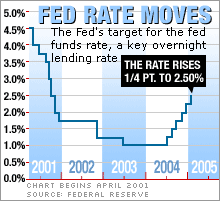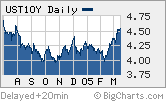 |
|
|
 |
| The 10-year Treasury yield is still lower than where it was last summer...despite six short-term rate hikes since. |
|
|
|
|
|
|
|
NEW YORK (CNN/Money) -
So long, measured. It was nice knowing you.
When Alan Greenspan and the rest of the Federal Reserve's Open Market Committee meet on March 22, a rate hike is all but guaranteed. According to the Chicago Board of Trade's federal funds future contract, traders are pricing in a 100 percent chance of an increase in short-term rates.
But many Fed watchers think that the most important thing to look out for is not what the Fed does, but what it says in its policy statement.
Since May, the Fed has indicated that it would likely raise rates at a "measured" pace. But there's a growing sense among market observers that the Fed will drop that language. Opinions on what exactly that would mean, however, are mixed.
With oil prices recently hitting a record high, the market is really starting to worry about inflation. And some think that if the Fed abandons the term "measured," that means the central bank also sees inflation as a bigger threat and thus might need to raise rates more aggressively to fight it.
Since June, the Fed has raised its target for the fed funds rate six times, a quarter point each time, bringing the overnight bank lending rate from a 40-year low of 1 to 2.5 percent.
Many believe that by the end of the year, short-term rates will wind up being somewhere between 3 and 5 percent, a so-called "neutral" level that should minimize inflationary pressures but not dampen economic growth. But is neutral closer to 3 percent or 5 percent?
Bond investors: listen up
Bill Davison, managing director of Hartford Investment Management, said the Fed may remove the word "measured" next week to prepare investors for possibly bigger rates hikes later this year. He expects the Fed funds rate to end this year at about 4 percent.
"Measured could go away," Davison said. "Greenspan wants the yield on the 10-year Treasury to go up because usually, long rates are not this low until late in a tightening cycle. The bond market may be underestimating how much more tightening needs to be done."
He thinks the Fed is particularly uncomfortable with long-term bond yields and wants to show investors that more rate hikes are needed to keep inflationary pressures at bay. The yield on the 10-year Treasury is currently about 4.47 percent, lower than where it was before the Fed started raising rates last summer.
To that end, there is a small group of traders betting on a half-point rate hike when the Fed meets next Tuesday. The fed funds contract on the Chicago Board of Trade has priced in an 8 percent chance the central bank will raise rates from 2.5 percent to 3 percent -- nearly double the odds of six weeks ago.
David Rolley, co-head of fixed income with Loomis Sayles and co-manager of the Loomis Sayles Global Bond fund, said the Fed may be especially worried about home price inflation, adding that Greenspan is trying to steer long rates higher to cool off the real estate market. Long-term rates have more of an effect on mortgage rates.
"The Fed may want higher bond yields because it might take some of the speculative froth out of demand for housing," said Rolley. If the Fed removes the measured language, he added, that would cause bond prices to drop and yields to rise. Bond prices and yields move in opposite directions.
Bond investors: We already have
Still, some say Greenspan's already accomplished his goal of bringing long-term rates up and that inflation is not as big of a concern as some are making it out to be. So the Fed might not have to raise rates more dramatically.
Since Greenspan said relatively low long-term rates coupled with rising short-term rates "remains a conundrum" in testimony to Congress last month, the 10-year has risen from about 4.10 percent.
"There is a real possibility that measured will be gone from the statement but that's not necessarily to say that the Fed is becoming more hawkish," said Tom Higgins, chief economist with Payden & Rygel, a money management firm based in Los Angeles. "At some point they have to remove measured and even though some people think it implies more aggressive action, I think it could mean the Fed is coming to an end of its tightening cycle," Higgins added.
Higgins noted that despite a big jump in producer prices in January, he's not overly worried about inflation since January's consumer price index (CPI) showed no major signs of price pressures. As such, he thinks a fed funds rate closer to 3 percent is reasonable.
Michael Cheah, manager of the SunAmerica GNMA and SunAmerica U.S. Government Securities fixed-income mutual funds, agrees that inflation is not a major problem, saying that until there is a sustainable pickup in the job market, there's no real need to worry.
"A lot of people are afraid that increases in the PPI will eventually spill over to the CPI but it's important to put things into perspective. The majority of the average cost of goods is from labor and wages are still under pressure," Cheah said.
Economists expect the so-called core CPI for February, which excludes the cost of food and energy, will rise just 0.2 percent. The figures are due next Wednesday. The PPI figures come out on Tuesday and economists are predicting a 0.1 percent rise in the core number.
With this in mind, Loomis Sayles' Rolley said that regardless of whether the Fed keeps the measured language, it is likely to stick with a measured pace. "Core inflation is not too bad. I see no reason for the Fed to deviate from its quarter-point moves," he said.
Still, Hartford's Davison said it would be a mistake to dismiss the threat of inflation.
"There's a joke in the fixed income world that the PPI and CPI excluding everything is zero. But you can't really discount everything," Davison said. "I'm not trying to be alarmist but the market is underestimating the inflation risk in the economy."
For more news about the Fed, click here.
For more about the bond markets, click here.

|